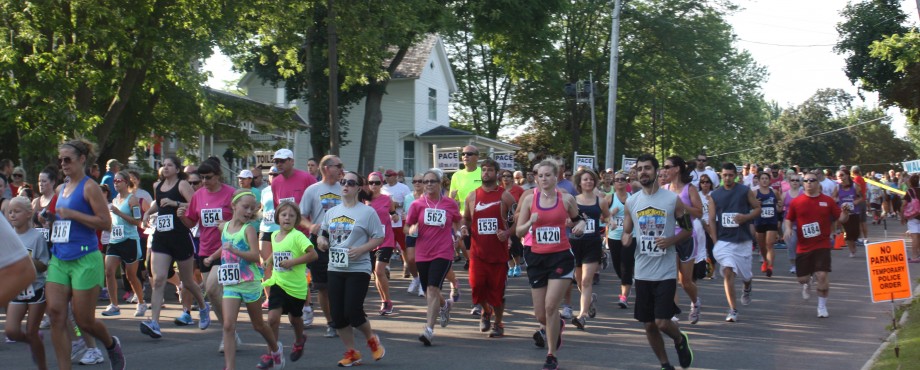Race Day Nutrition
by Dietitian, Krista Loos, RD – KSB Hospital
The 2021 Reagan Run is coming up on Saturday, July 3rd , so it’s not too early to start thinking about your race day nutrition. The information below is great if you are a first time participant to the Reagan Run or if you compete in 5K races throughout the year. Good nutrition will help you maximize your race day results and help with recovery after the race. Enjoy the healthy post-race snacks after the Reagan Run.
Carbohydrate’s and performance
Carbohydrates are an important fuel source for exercise. It is important to consume adequate carbohydrates to help fuel muscle contraction. Inadequate carbohydrate intake may impact performance
What foods have carbohydrates?
Whole grains, baked goods, crackers, legumes, starchy vegetables, fruits, milk, yogurt (this list is not comprehensive).
Tips on tummy troubles with eating and exercise
For recreational athletes it is best to choose a well-balanced diet prior to exercise that includes whole grains, fruits, vegetables, protein, and dairy products. Some athletes may experience abdominal discomfort with moderate to high fiber intake around exercise. Some athletes may also experience some GI discomfort with dairy consumption too close to race time. Each person is extremely individualized and what works for one person may not work for you. Practice your eating routine prior to race day. Choose a training day and treat it like race day; see how your stomach tolerates the before race meal prior to implementing it on race day.
Timing of intake
Timing of intake may depend on the distance/intensity of the race, as well as how your stomach tolerates food prior to exercise. Try to consume easily digestible carbs that you have eaten during training and tolerate well. Also include protein with your meal to help prevent hunger during exercise. Try to avoid large quantities of high fat food prior to training, as this may cause stomach discomfort because fat takes longer to digest (i.e. maybe wait to eat bacon until after the race). Try to eat a meal 3-4 hours prior to racing and a small snack about 1-2hrs before to help top off fuel stores in your muscles and liver. If you do not have time to eat a meal 3-4 hours prior to competition, make sure your meal the night before is rich in carbohydrates and consume a small meal 1-2 hours prior to competition that includes carbohydrates and protein.
Examples of meals that include carbohydrates and protein:
Bagel with peanut butter, 1 serving 100% fruit juice
Slice of toast with peanut butter, banana slices and honey
Oatmeal with peanut butter and berries
Hydration
Stay hydrated! It is important to drink water consistently and not a large quantity all at once. Try to drink small equal sized sips the morning leading up to the race, as opposed to an entire water bottle all at once. A sports drink may be beneficial to include after your workout to help replenish electrolytes lost in sweat. Make sure you take into consideration the temperature on race day, because as we move into the summer months with warmer weather you need to pay extra close attention to your hydration status. You may also want to consider wearing breathable, sun protective clothing and accessories (hat, sunscreen etc.) to help prevent overheating.
Refueling after exercise
After your race make sure you follow the three R’s of post-exercise nutrition. Rehydrate: (consume water and some sports drink) to replenish fluids and electrolytes. Refuel: consume carbohydrate rich foods to help replenish glycogen stores in your muscles. Repair: consume a protein rich food to help repair any muscle damage during exercise.
A smoothie is a great post workout snack as it contains fluid (milk or juice), protein (milk and yogurt), carbohydrates (fruit, yogurt, milk) and has the added bonus of antioxidants in the fruit & vegetables to help with inflammation following exercise.
| 1 | Banana (broken into chunks, can be frozen too) |
| 1 cup 1 cup | Strawberries (frozen) (or any of your favorite fruits) Spinach leaves, fresh (or frozen) |
| 1 (8 ounce) container | Vanilla Low-Fat Yogurt, (Greek if you like it) |
| ¾ cup | Milk, low fat |
Directions:
Add all ingredients to the blender and blend until desired consistency (if you prefer it to be thicker or thinner adjust the amount of milk accordingly. More milk for thinner smoothies and less milk for thicker smoothies). Serves 2-3
Overall, make sure that you are including all food groups and balancing out your plates with plenty of fruits and vegetables, whole grains, lean protein options and dairy products. Proper nutrition plays a vital role in exercise performance. If you have any questions about the nutrition information provided or nutrition counseling please email me at kloos@ksbhospital.com.
